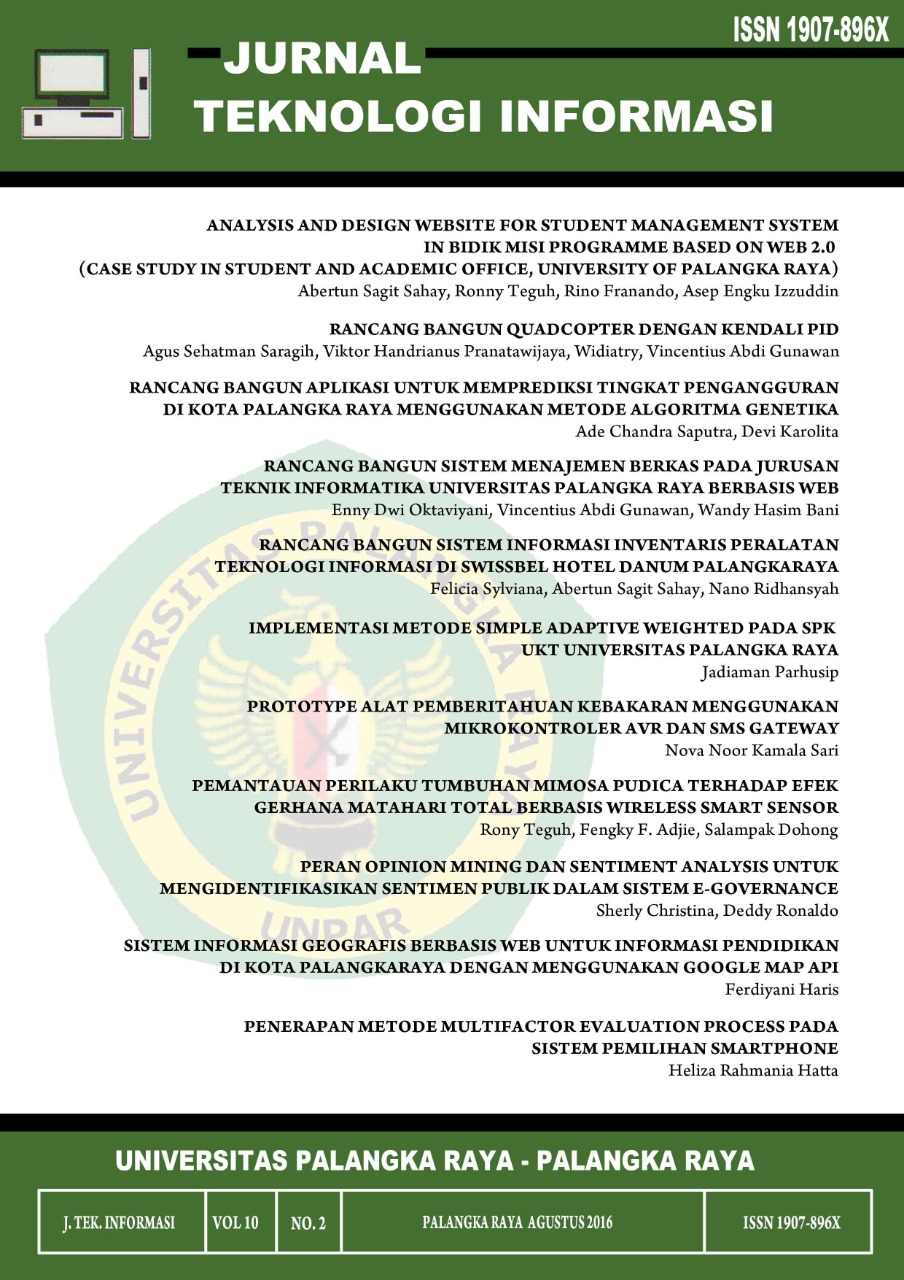PEMANTAUAN PERILAKU TUMBUHAN MIMOSA PUDICA TERHADAP EFEK GERHANA MATAHARI TOTAL BERBASIS WIRELESS SMART SENSOR
DOI:
https://doi.org/10.47111/jti.v10i2.1432Keywords:
wireless sensor network, the behavior of plants, leaf movement, the sensor nodeAbstract
The phenomenon of a total solar eclipse (total solar eclipse) can only occur within a period of 100 years, until now, even the natural phenomena related research is very interesting to do mainly related to metabolic processes that occur in green plants or high level. In the study, the behavior of Mimosa pudica plant will be measured by using a sensor device. The sensor device with PISA algorithm will monitor environmental factors such as light intensity, temperature, humidity and atmospheric pressure at the time of a solar eclipse total. In this case, changes in the behavior of Mimosa pudica plant to sunlight will be validated by using a digital camera to obtain information leaf movement. The results of this study the sun upon the occurrence of a total eclipse, the temperature conditions around the plant Mimosa pudica average 26oC. The movement of the leaves of Mimosa pudica move to close when the temperature of 25° C at 07. 43 pm. Leaves of Mimosa pudica reopened at 7:52 pm when the temperature is more than 27oC. sunlight at 7:24 o'clock pm at the time of the total solar eclipse of 1800 Lux. From the results of the measurements, light intensity sensor node at 07:25 - 07.29 pm downhill until the condition is 0 Lux, which means the condition is very dark with no light around the plant. From the results of measurements made at 07:39 hours GMT where the changes in air temperature around the leaf on the value of 25.59°C and light intensity levels 1729.4 Lux, Mimosa pudica leaves start to close. By the time the sun began to shine the light level the surface of the leaves, and the air temperature increases, the leaves of Mimosa pudica made the decision to seal the surface of the leaf, after 3 minutes the leaves will open again because there is no stimulus temperature and light. This research also analyzed the data with modeling RGB on the surface of the leaves to get the data chlorophyll Before the solar eclipse average picture chlorophyll on the leaf surface is 0.68149. By the time the sun shone on the condition of 3% on average 0.15494 prior to the occurrence of a total solar eclipse. On the condition of the leaves cover the average - average 0.29555, and after a solar eclipse passing and riding conditions and uneven irradiation, the average value of chlorophyll on the leaf surface is 0.54612.
Downloads
References
Abd El-Kader, S.M., Mohammad El-Basioni, B.M., 2013. Precision farming solution in Egypt using the wireless sensor network technology. Egypt. Informatics J. 14, 221–233. doi:10.1016/j.eij.2013.06.004
Akyildiz, I.F., Su, W., Sankarasubramaniam, Y., Cayirci, E., 2002. Wireless sensor networks: a survey. Comput. Networks 38, 393–422. doi:10.1016/S1389-1286(01)00302-4
Teguh, R., Honma, T., Usop, A., Shin, H., Igarashi, H., 2012. Detection and Verification of Potential Peat Fire Using Wireless Sensor Network and UAV. Proceeding Int. Conf. Inf. Technol. Electr. Eng. 6–10.
Yadav, S.P., Ibaraki, Y., Gupta, S.D., 2010. Estimation of the chlorophyll content of micropropagated potato plants using RGB based image analysis. Plant Cell. Tissue Organ Cult. 100, 183–188. doi:10.1007/s11240-009-9635-6
Yan, X., Wang, Z., Huang, L., Wang, C., Hou, R., 2009. Research progress on electrical signals in higher plants. Prog. Nat. Sci. 19, 531–541. doi:10.1016/j.pnsc.2008.08.009
Yoon, I., Noh, D.K., Lee, D., Teguh, R., Honma, T., Shin, H., 2012. Reliable wildfire monitoring with sparsely deployed wireless sensor networks, in: Proceedings - International Conference on Advanced Information Networking and Applications, AINA. pp. 460–466.
Zhou, B., Hu, C., Wang, H., Guo, R., Meng, M.Q.H., 2007. A wireless sensor network for pervasive medical supervision. IEEE ICIT 2007 - 2007 IEEE Int. Conf. Integr. Technol. 740–744. doi:10.1109/ICITECHNOLOGY.2007.4290419












